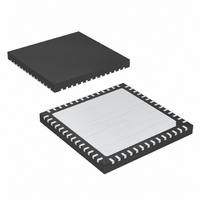MAX16048ETN+ Maxim Integrated Products, MAX16048ETN+ Datasheet - Page 51

MAX16048ETN+
Manufacturer Part Number
MAX16048ETN+
Description
IC EE-PROG SYS MGR 8CH 56-TQFN
Manufacturer
Maxim Integrated Products
Type
System Managerr
Datasheet
1.MAX16046EVKIT.pdf
(70 pages)
Specifications of MAX16048ETN+
Number Of Voltages Monitored
8
Output
Open Drain, Push-Pull
Reset
Active Low
Reset Timeout
Adjustable/Selectable
Voltage - Threshold
Adjustable/Selectable
Operating Temperature
-40°C ~ 85°C
Mounting Type
Surface Mount
Package / Case
56-TQFN
Manual Reset
Resettable
Watchdog
Yes
Supply Voltage (max)
14 V
Supply Voltage (min)
3 V
Supply Current (typ)
6500 uA
Maximum Power Dissipation
3810 mW
Mounting Style
SMD/SMT
Maximum Operating Temperature
+ 85 C
Minimum Operating Temperature
- 40 C
Lead Free Status / RoHS Status
Lead free / RoHS Compliant
The send byte protocol allows the master device to
send one byte of data to the slave device (see Figure
12). The send byte presets a register pointer address
for a subsequent read or write. The slave sends a
NACK instead of an ACK if the master tries to send a
memory address or command code that is not allowed.
If the master sends 94h or 95h, the data is ACK,
because this could be the start of the write block or
read block. If the master sends a STOP condition
before the slave asserts an ACK, the internal address
pointer does not change. If the master sends 96h, this
signifies a software reboot. The send byte procedure is
the following:
1) The master sends a START condition.
2) The master sends the 7-bit slave address and a
3) The addressed slave asserts an ACK on SDA.
4) The master sends an 8-bit memory address or com-
5) The addressed slave asserts an ACK (or NACK) on
6) The master sends a STOP condition.
The receive byte protocol allows the master device to
read the register content of the MAX16046/MAX16048
(see Figure 12). The EEPROM or register address must
be preset with a send byte or write word protocol first.
Once the read is complete, the internal pointer increas-
es by one. Repeating the receive byte protocol reads
the contents of the next address. The receive byte pro-
cedure follows:
1) The master sends a START condition.
2) The master sends the 7-bit slave address and a
3) The addressed slave asserts an ACK on SDA.
4) The slave sends 8 data bits.
5) The master asserts a NACK on SDA.
6) The master generates a STOP condition.
The write byte protocol (see Figure 12) allows the mas-
ter device to write a single byte in the default page,
extended page, or EEPROM page, depending on
System Managers with Nonvolatile Fault Registers
write bit (low).
mand code.
SDA.
read bit (high).
12-Channel/8-Channel EEPROM-Programmable
______________________________________________________________________________________
Receive Byte
Write Byte
Send Byte
which page is currently selected. The write byte proce-
dure is the following:
1) The master sends a START condition.
2) The master sends the 7-bit slave address and a
3) The addressed slave asserts an ACK on SDA.
4) The master sends an 8-bit memory address.
5) The addressed slave asserts an ACK on SDA.
6) The master sends an 8-bit data byte.
7) The addressed slave asserts an ACK on SDA.
8) The master sends a STOP condition.
To write a single byte, only the 8-bit memory address
and a single 8-bit data byte are sent. The data byte is
written to the addressed location if the memory address
is valid. The slave will assert a NACK at step 5 if the
memory address is not valid.
The read byte protocol (see Figure 12) allows the mas-
ter device to read a single byte located in the default
page, extended page, or EEPROM page depending on
which page is currently selected. The read byte proce-
dure is the following:
1) The master sends a START condition.
2) The master sends the 7-bit slave address and a
3) The addressed slave asserts an ACK on SDA.
4) The master sends an 8-bit memory address.
5) The addressed slave asserts an ACK on SDA.
6) The master sends a REPEATED START condition.
7) The master sends the 7-bit slave address and a
8) The addressed slave asserts an ACK on SDA.
9) The slave sends an 8-bit data byte.
10) The master asserts a NACK on SDA.
11) The master sends a STOP condition.
If the memory address is not valid, it is NACKed by the
slave at step 5 and the address pointer is not modified.
write bit (low).
write bit (low).
read bit (high).
Read Byte
51












